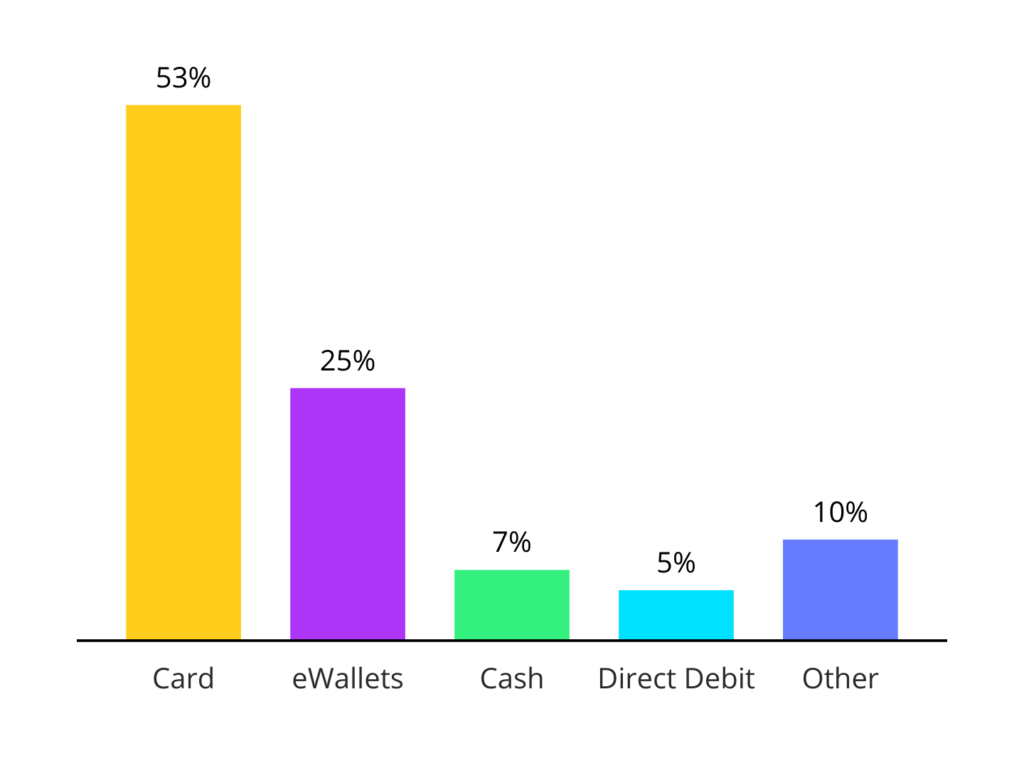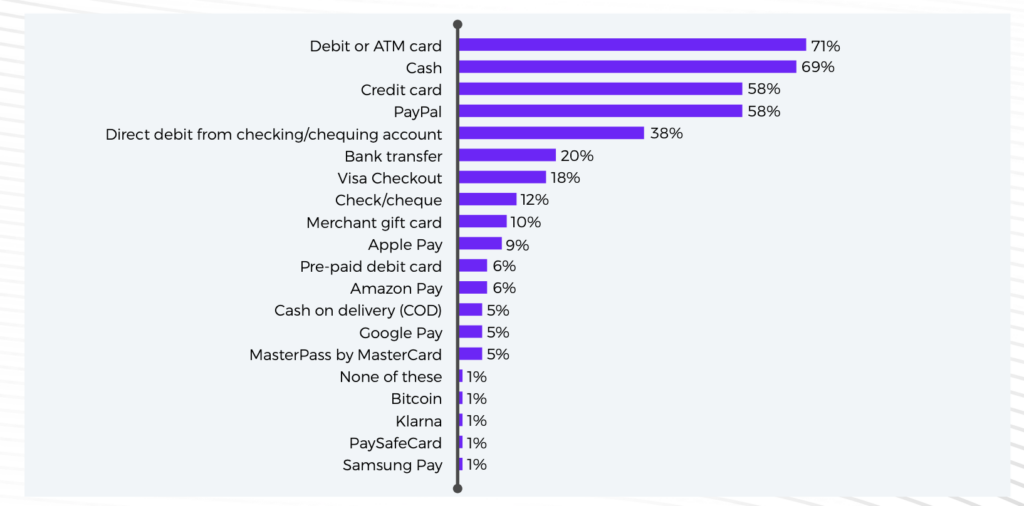Ecommerce is alive and growing in the U.K.1 Even as physical stores shuttered during the pandemic, ecommerce has gone on to take its largest-ever share of retail spending—22.3% of all sales, according to trade magazine Internet Retailing (1). The U.K. has an incredibly dynamic ecommerce market that generated over 6% of the country’s GDP.2
The United Kingdom at a Glance
- Population: 66 million3
- GDP per capita: US$42,9434
- eCommerce market value: €178.5 billion3
- Mobile commerce market value: €91 billion3
- % of population using the internet: 94.7%3
- % of adults with a smartphone: 70.8%3
- % of population with bank accounts: 96.4%3
- % of population with credit cards: 65%3

Offer All the Payment Methods that Drive Sales in the United Kingdom
Discover Rapyd’s All-in-One payments solution for the U.K.
eCommerce Trends in the United Kingdom
Prior to Brexit, the U.K. had the second-largest economy of Europe, making it a massive powerhouse not only in the region but in the world. Whatever happens after Brexit, the fact remains that U.K. consumers across multiple age demographics love shopping in-person and online. If anything, COVID-19 will ultimately push more people into choosing ecommerce—at least for the foreseeable future.
These are the trends driving ecommerce in the U.K.
1. U.K. Online Shoppers Spend More than the Average European
The U.K.’s overall per capita spend is €3,344, while the European average sits at €2,186.24.3 To serve the U.K. market properly, however, means taking a very careful look at who is shopping. Women’s fashion is a massive sector for ecommerce in the U.K. The nation has an average age of 40.5 years. More and more people in the 35–44 age demographic are shopping online–and they’re the biggest spenders.3 Online commerce companies in the U.K. should be aware of the demographics they’re actually serving and tailor their shopping and payment experiences accordingly.
2. Mobile eCommerce Growth Is Strong and Getting Stronger
Mobile ecommerce accounts for €91 billion in annual sales, or about half of all online B2C retail, according to JP Morgan, which says: “In terms of scale, the U.K. mobile commerce market dwarfs all others in Europe.3″
In-app shopping is already popular, and becoming more so. A survey done in the U.K. said 61.4% of consumers preferred apps, versus mobile websites.6 Mobile shopping is heavily preferred by younger shoppers, but in the same survey a majority of people over 65 said they didn’t trust the security of mobile shopping.
3. Cards Remain the Top Payment Method, but eWallets Are Gaining Steam
Cards still have a firm grip on ecommerce payments. But as mobile shopping grows, so does ewallet popularity. eWallet use is growing at twice the pace of cards,3 with PayPal leading the way. The adoption of ewallets in the U.K. may accelerate even more as online shoppers embrace more cross-border shopping with the rest of Europe now that they’re out of the EU.
United Kingdom Ecommerce Snapshot
- Annual ecommerce revenue: US$89.9 billion7
- Average ecommerce revenue per user: US$1,325.508
- % of ecommerce purchases that are cross-border: 4%9
- % of population making online purchases: 66%10
- Projected ecommerce growth: 5.9% CAGR from 2018–20239
Top merchant segments:9
- Fashion: 30%
- Toys, hobby and DIY: 19%
- Electronics and media: 19%
- Furniture and appliances: 15%
- Food and personal care: 5%
Top Payment Methods in the U.K. Ecommerce Payment Methods Split By Spend-Per-Method (by value)3

Which of the following payment methods did you use in the past three months?

Knowing Your Customers Is Key to U.K. Success
The United Kingdom requires a multifaceted approach that boils down to having different shopping experiences and payment options for different types and ages of shoppers. Whether you’re a domestic or foreign company looking to grow, it will pay off to know exactly who your target market is and optimize both your UX and your payment options for them.
While customization is key, providing payment options also helps you to keep the door open for new customers. It’s happened more than once that companies stumble upon markets they didn’t know their products would appeal to. Designing shopping and payment experiences that respond to different demographics’ needs is essential to capturing as many loyal customers as possible.
Discover Rapyd’s All-in-One payments solution for the U.K.
Sources:
- https://internetretailing.net/industry/industry/uk-retail-sales-fall-at-fastest-rate-ever–while-ecommerce-takes-record-share-of-spending-21298
- http://www.digitalclaritygroup.com/brexit-impact-cross-border-e-commerce/
- https://www.jpmorgan.com/merchant-services/insights/reports/united-kingdom
- https://data.worldbank.org/indicator/NY.GDP.PCAP.CD?page=1
- https://tcdata360.worldbank.org/indicators/h83ea0f24?country=GBR&indicator=3360&countries=BRA&viz=line_chart&years=2011,2017
- https://www.retail-insight-network.com/comment/mobile-shopping-uk/
- https://www.statista.com/outlook/243/156/ecommerce/united-kingdom
- https://www.statista.com/statistics/891172/e-commerce-arpu-in-united-kingdom/
- https://www.statista.com/outlook/243/156/ecommerce/united-kingdom
- https://www.tradecommissioner.gc.ca/guides/uk_e-commerce-commerce_electronique_ru.aspx?lang=eng
Subscribe Via Email
Thank You!
You’ve Been Subscribed.



